Conservation of an Imperial German Pith Helmet
Exhibition object
This Imperial German Consular Service pith helmet is part of Forging the Nation, Federation - the first 20 years, the Australian War Memorial's exhibition celebrating the Centenary of Federation. The helmet was worn by Major Friedrich Wilhelm Von Ploennies, German consul in Brisbane in the late 1890's, as part of his formal uniform. The helmet, which is a good example of imperial imagery, was included in the exhibition to illustrate that Germany had extensive colonies in the South West Pacific. When war was declared in 1914, one of the first acts in Australia was to seize many of these possessions, changing Australia from a colony into a colonial power.
Construction
The helmet is constructed of two layers of moulded cork, and is covered with a stitched and fitted cream - coloured drill fabric which is then glued over the cork. Various brass components including a chin strap, spike base, spike with horsehair plume have then been attached to the helmet to complete it.
Condition
The pith helmet was in poor condition when it was accepted into the Australian War Memorial's collection. The fragile cork of the crown had cracked and collapsed as the result of old water damage and there was extensive brown water staining of the fabric covering. The metal fittings were also tarnished and most of the pipe clay coating which would have been applied to the helmet to keep it white had disappeared.
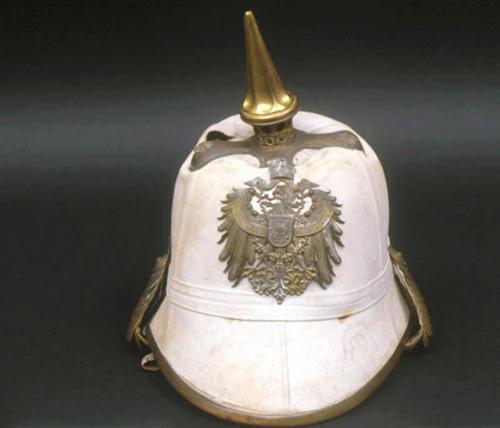
Treatment
As with all conservation treatments the first step was the examination of the object and documentation of its construction and condition using diagrams and photographs. This is done to inform the conservator about the nature of the object including the materials of construction, the way those materials have been put together, and the extent and causes of deterioration before any treatment procedure in formulated.
Where possible, conservators seek to stabilize and minimize the chemical and physical deterioration of heritage objects to prolong their existence. Minimal intervention in the fabric of the object is highly desirable. However, conservation treatment may involve restoration to return the object to an earlier, known state where damage and deterioration is severe. The degree of damage to this helmet warranted a full restoration treatment
The biggest challenge was to re-contruct the damaged crown of the helmet so that it could support the weight of the brass fittings. It was decided that it would be necessary to remove the broken pieces of cork and replace them with a new crown.
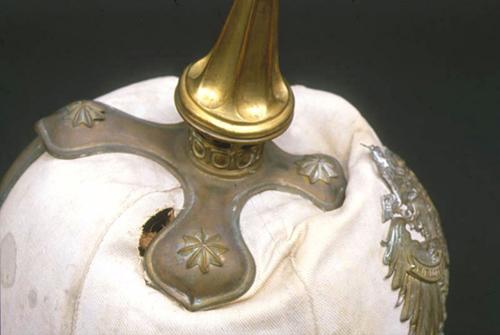
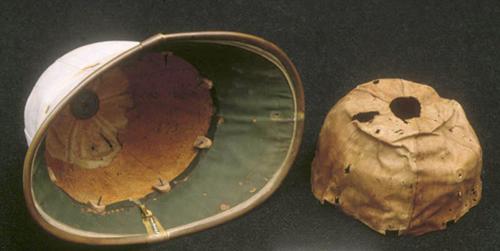
Conservation practice demands that only materials that are highly chemically stable with good aging properties that are not detrimental to the object, be used in treatments. Many commercially available products have poor aging properties and can cause damage to the objects to which that added as they deteriorate over time. The helmet was supported upside down and the crown lined to prevent the fill material coming into direct contact with the fabric. A stiff epoxy fill was made from a conservation-grade epoxy and bulking agent, and pressed into the crown ensuring that the fill conformed to the correct shape for the helmet. Once the fill was cured and hard, it provided a rigid, lightweight, removable fill which could support with weighty brass fittings and give the object its correct shape.
The metal fittings were lightly cleaned to remove the tarnish and then waxed to prevent retarnishing from occuring. After careful consideration, it was decided that the fabric surface should be recoated with pipe clay to cover the water staining and restore the helmet to its original appearance.
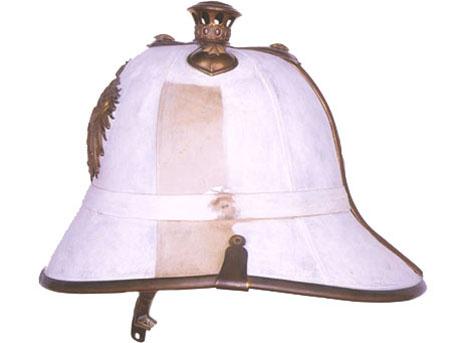
Display
After 74 hours of treatment the helmet was restored to its Federation appearance and was included in the Forging the Nation exhibition which was on display at the Memorial and in other venues from October 2000 and February 2002.
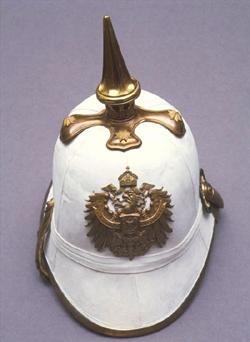
Contributors: Sarah Clayton and Gina Drummond